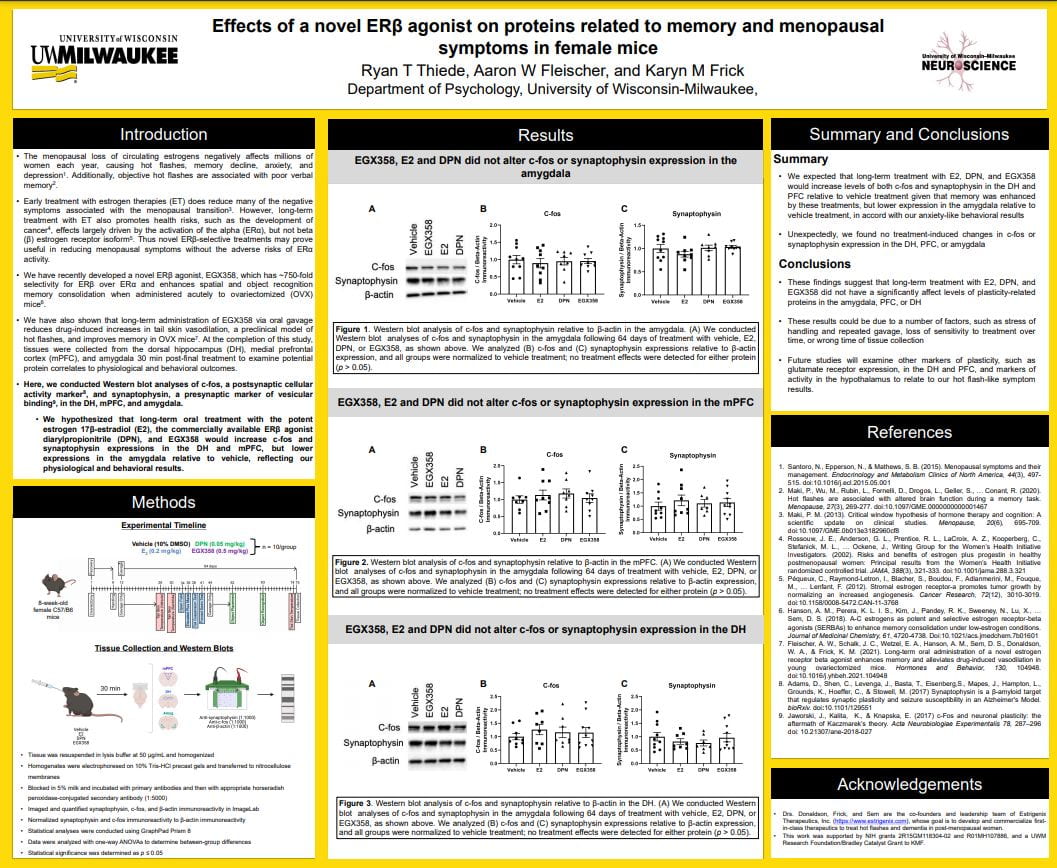Ryan Thiede, “Effects of a Novel ERb Agonist on Proteins Related to Memory and Menopausal Symptom in Female Mice”
Mentor: Karyn Frick, Psychology
Millions of women experience menopausal symptoms, such as hot flashes, anxiety, depression, and dementia every year. We tested the use of EGX358, a novel highly selective estrogen receptor beta (ERb) agonist, as a potential hormone-related treatment for preclinical indices of these menopausal symptoms. To do this, we ovariectomized young female mice and gave them 64 days of oral gavage treatment with vehicle, the estrogen 17β-estradiol (E2), a less-potent ERb agonist diarylpropionitrile (DPN), or EGX358. Mice underwent tasks to measure memory and hot flash-, anxiety-, and depression-like indices. All treatments reduced hot flashes and enhanced memory but had no effects on anxiety- and depression-like behaviors. The beneficial effects of treatment on memory and hot flashes suggested there may have been some changes in the brain that reflect those differences. Brains were collected 30 minutes following the final gavage treatment to look for protein changes in the dorsal hippocampus (DH), amygdala, and medial prefrontal cortex (mPFC). These brain regions were of interest because they play important roles in memory (DH, mPFC) and affective (amygdala) behaviors. We analyzed Western blots in ImageLab software to quantify immunoreactivity of two proteins involved in neural activity and synaptic plasticity, the immediate early gene c-fos and presynaptic protein synaptophysin, respectively. Immunoreactivity for each protein was normalized to b-actin, and between-group differences were statistically analyzed in GraphPad Prism. We expected that estrogen treatments would increase levels of both proteins in the DH and PFC given that memory was enhanced by these treatments, but instead found no treatment-induced changes in these proteins. Treatment also did not alter protein levels in the amygdala. Future studies will examine other markers of plasticity, such as glutamate receptor expression, in the DH and PFC, and markers of activity in the hypothalamus to relate to our hot flash-like symptom results.
Click the thumbnail below to open the full sized poster in a new tab.

Very interesting study and fairly clear explanation of a complex topic. I was left wondering (1) why you used young mice when menopause is related to older ages?; (2) do mice and humans age similarly? and (3) what might be an explanation for the null findings? I think this project would have been easier to understand if the presentation was done orally; for example I had a hard time making sense of the figures and would have benefitted from hearing the research explaining and interpreting. Nonetheless, this project was quite well done and impressive.